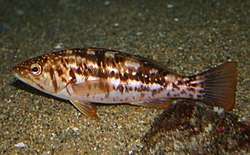Paralabrax clathratus
Paralabrax clathratus, the kelp bass, sometimes referred to as the Calico bass (leading to easy confusion with the freshwater fish from the genus Pomoxis), is a species of marine fish found in the eastern North Pacific Ocean from Baja California, Mexico, to Washington, United States[1] (although rare in the northernmost part of its range).[2] As suggested by its common name, it is typically associated with kelp beds, but may also be found in rocky areas or near hard structures.[3] It prefers relatively shallow water, but may occur as deep as 165 ft (50 m).[1]
| Kelp bass | |
|---|---|
 | |
| Scientific classification | |
| Kingdom: | |
| Phylum: | |
| Class: | |
| Order: | |
| Family: | |
| Genus: | |
| Species: | Paralabrax clathratus |
| Binomial name | |
| Paralabrax clathratus (Girard, 1854) | |
| Synonyms | |
|
Labrax clathratus Girard, 1854 | |
It can reach a length of 29 1⁄2 inches (75 cm), and, being a slow grower, live for as long as 34 years.[1] It is considered an excellent food fish, and is a popular recreational fishery species in Southern California. While the population is believed to be stable, large individuals are relatively rare due to fishing pressure.[2] Commercial fishing for this species has been illegal since the 1950s.[3] Current regulations in California allow only 14-inch or longer kelp bass to be kept by recreational fishermen.
It feeds on small fishes, squid, crustaceans, and, when abundant, plankton.[1] During the warmer months (May to September in California),[1] kelp bass form spawning groups in deeper water.[4] After one to two days, the pelagic eggs hatch into larvae, which metamorph into juveniles after about a month. The juveniles settle among blades of kelp. Kelp bass have been known to bite at humans; a bite can break the skin, but does not usually cause severe puncture wounds. This may be more frequent when the fish are spawning.[3]
Etymology
Paralabrax comes from two Greek words which mean "near Labrax". Labrax is the name of the European seabass (Dicentrarchus labrax). Clathratus is also Greek, and refers to the color of the stripes lining the fish's side.
References
- "Kelp bass: Paralabrax clathratus (Girard, 1854), Fish Base
- Kelp bass (PDF) - California Department of Fish & Game. Accessed 28 February - 2008.
- About Calico Bass - Calico Bass Tagging Project. Accessed 28 February - 2008.
- Kelp bass Archived 2008-06-01 at the Wayback Machine - Dr. Larry G. Allen. mdranglers. Accessed 28 February - 2008.
External links
- Photos of Paralabrax clathratus on Sealife Collection
